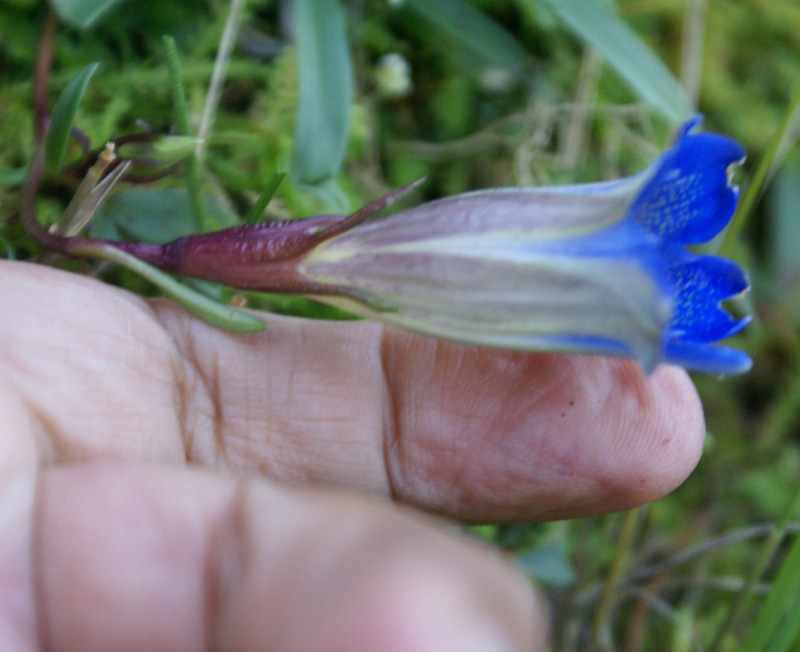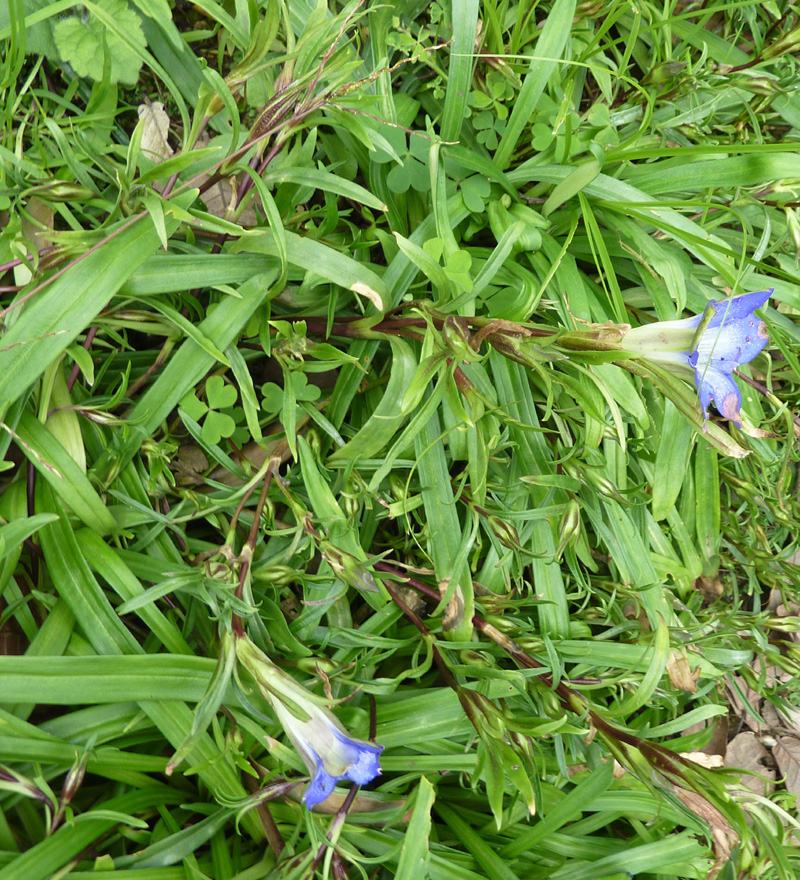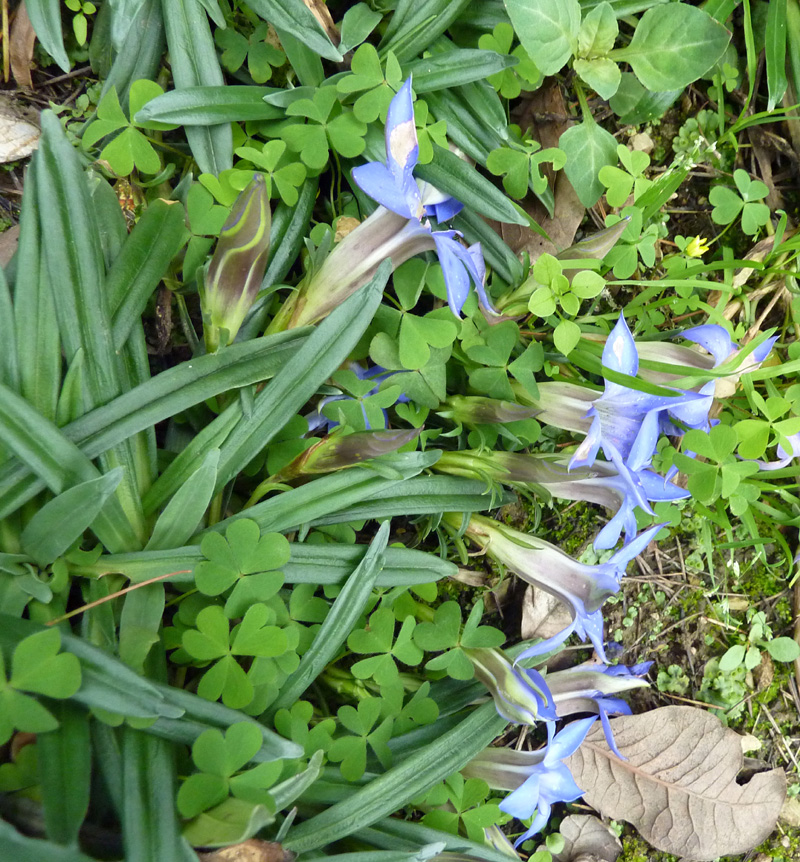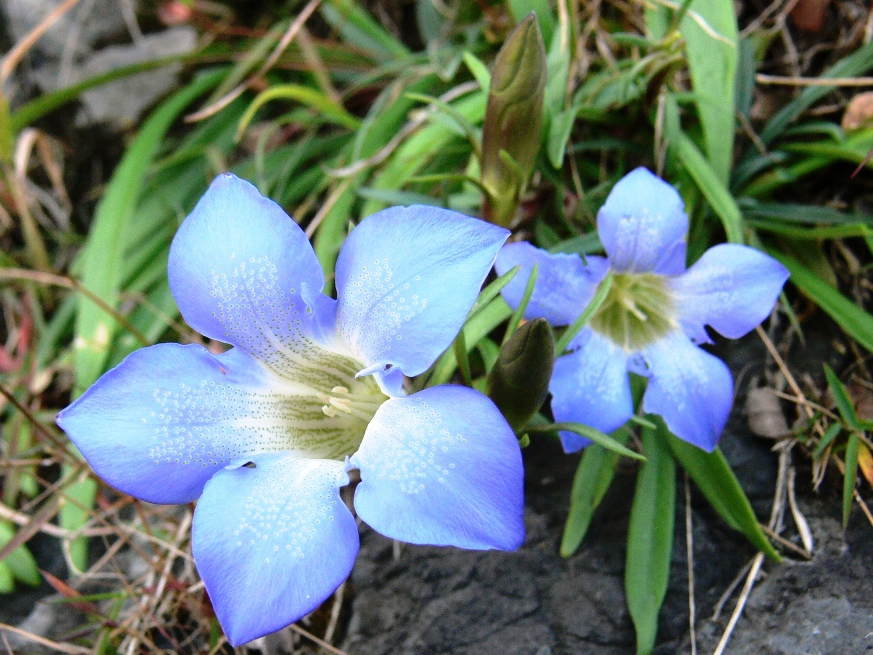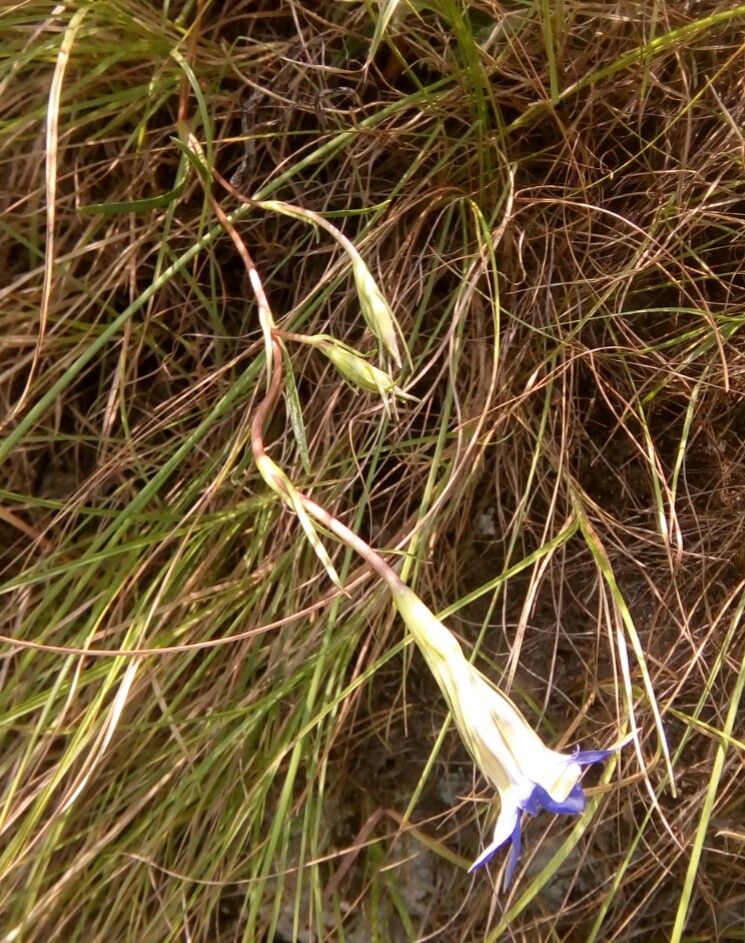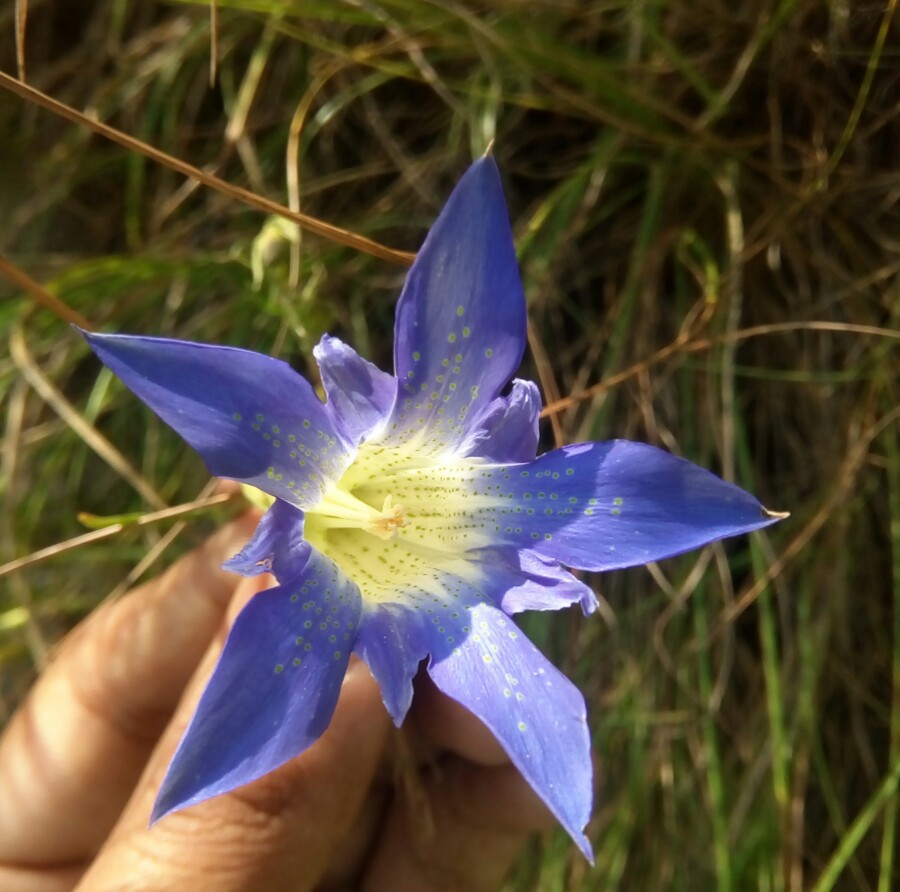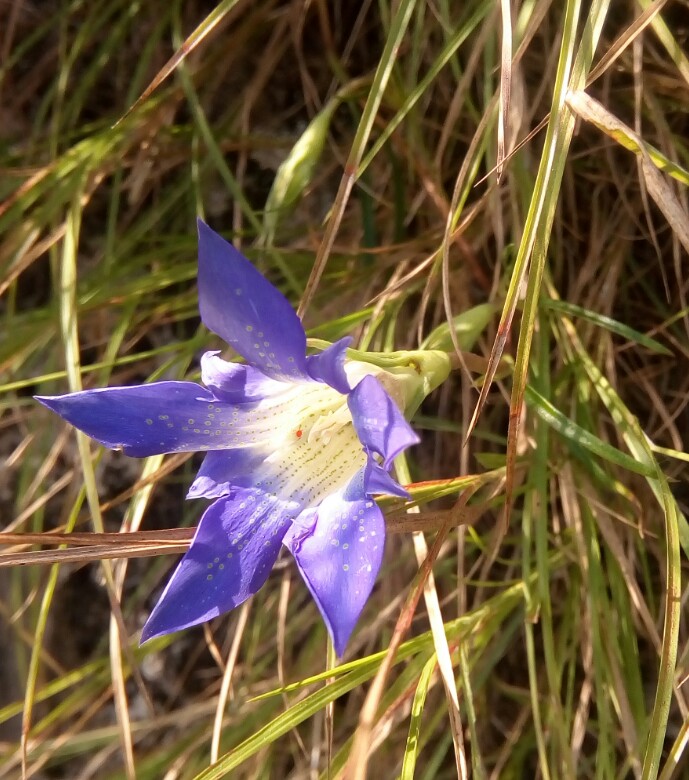|
IUCN Red List Status: Critically Endangered (CR)
Gentiana kurroo Royle, Ill. Bot. Himal. Mts. 278 1835. (Syn: Gentianodes kurroo (Royle) Omer, Ali & Qaiser; Pneumonanthe kurroo G.Don (Unresolved); Tretorhiza kurroo (Royle) Soják (Unresolved)); Flora of Chakrata: Gentiana kurroo from Dev Van Herbal garden and Budher caves Rod: Gentiana kurroo from Dev Van Herbal garden and Budher caves Rod
Pls validate
Yes …, the real pleasure was to see it on the rocky cliff. Yes Sir, To see this as wild was really great pleasure A bitter tonic both in Ayurvedic herbals and western herbal traditions.. many breweries also make concoctions of gentian roots… seems its very popular around the world. I love the bloe color.. and your pictures depicting the leaves and rosettes are priceless… not often seen in herbal medicine books…
Campanulaceae & Gentianaceae Week: Gentianaceae-Gentiana kurroo from Chakrata: Gentiana kurroo Royle, Illustr. Bot. Himal. 278, t. 68. f. 2. 1835. Syn: Gentianodes kurroo (Royle) Omer
Robust perennial herb up to 25 cm tall, branched from base, rhizome thick; basal leaves linear-oblong, up to 12 cm long, with slightly reflexed margin, apex acute; cauline leaves linear, base forming a tube; flowers blue, solitary, up to 6 cm long; calyx tube 1-2 cm long, lobes unequal 10-15 mm long; corolla tube 2-5 cm long, lobes ovate, up to 12 mm long; plicae ovate, short; capsule 2-3 cm long on 8-12 mm long stalk.
Photographed Deovan Herbal Garden and along Budher Caves Chakrata Road.
Sir, please mention the date of collection and which month of the year it was flowering as I have to collect this plant for my research purposes
This was in middle of September, 2011. Campanulaceae & Gentianaceae Week: Gentianaceae :: Gentiana kurroo from Herbal Garden Deovan Chakrataa: Gentiana kurroo from Herbal Garden Deovan Chakrata
Campanulaceae and Gentianaceae week: Gentiana kurroo from Chakrata: This one is Gentiana kurroo Royle, shot from Herbal park and Nursery, Deoban in September 2011…
Campanulaceae & Gentianaceae Fortnight: Gentianaceae-Gentiana kurroo from Chakrata-GSJUL11 : 2 posts by 2 authors. Attachments (3). Gentiana kurroo Royle, Illustr. Bot. Himal. 278, t. 68. f. 2. 1835.
Syn: Gentianodes kurroo (Royle) Omer
Robust perennial herb up to 25 cm tall, branched from base, rhizome thick; basal leaves linear-oblong, up to 12 cm long, with slightly reflexed margin, apex acute; cauline leaves linear, base forming a tube; flowers blue, solitary, up to 6 cm long; calyx tube 1-2 cm long, lobes unequal 10-15 mm long; corolla tube 2-5 cm long, lobes ovate, up to 12 mm long; plicae ovate, short; capsule 2-3 cm long on 8-12 mm long stalk.
Photographed Deovan Herbal Garden and along Budher Caves Chakrata Road.
Nice sir, first time I see this plant. Thanks for uploading
Campanulaceae & Gentianaceae Fortnight:: Gentiana kurroo from Chakrata :: NS 01 : 4 posts by 3 authors. Attachments (4).
This was shot from Deoban Herbal Nursery in Chakrata.. perhaps this is hard to find in wild now..
Gentiana kurroo …
Yes it has become rare in the area. Earlier known in wild.
Campanulaceae & Gentianaceae Fortnight: Gentiana kurroo from Himachal : GSG-09 : 4 posts by 3 authors. Attachments (3).
Gentiana kurroo from Himachal [Sangrah, Dist. Sirmour, 1700 m asl].
This Indian Gentian forming source of medicinally important ‘Trieman’ roots, has been assessed as Critically Endangered in the wild. I feel happy to share that our focused efforts have resulted in identification of perhaps the last remnant viable population of this species on precipitous grassy slopes near Sangrah in Kinnaur district of Himachal. This site bearing an estimated 500 plants of this species has been demarcated and set aside as Medicinal Plant Conservation Area (MPCA) as an in situ conservation measure for this species. Some photographs from this area… I think yes
Very good photographs
I firmly believe that our efforts in Himachal will ensure long-term conservation of this species. Thanks for nice images and information … such efforts are real need of the hour and many more species are required to be covered.. Sorry, the colony in Kinnaur is not the only viable population of Gentiana kurroo in the wild. I was given directions to a sizeable colony not that far from Mussoorie some years back by a ‘Britisher’ Doctor and plant enthusiast who worked at a medical camp in the region and came across this late autumn flowering spectacular gentian. There is no reason not to think that it is not found in similar habitat along the full length of its range. If you do not know where to look, you will not find it…..
And DO read the EVIDENCE from Pakistan about this gentian which I provide at the end of my comments.
Unfortunately, it is ESSENTIAL to be able to ACCURATELY and RELIABLE identify plants before they can be conserved or understood.
I have just come across: http://www.scind.org/297/Environment/need-for-the-conservation-of-gentiana-kurroo-a-critically-endangered-medicinal-plant.html. The problem is that whilst the photo to accompany this article is a gentian, it is NOT Gentiana kurroo. Rather a serious mistake.
Indian scientists are not alone misidentifying this plant, see: https://www.flickr.com/photos/26181971@N07/5982536972 – the gentian being grown in this botanic garden is not Gentiana kurroo….
And it does not end there, a firm CLAIMING to supply quality Gentiana kurroo has a photo of a gentian which is NOT Gentiana kurroo…. see: http://www.himalyanassets.com/gentiana-kurroo.htm
Or you could pay for an image of Gentiana kurroo which is NOT Gentiana kurroo. See: https://www.gapphotos.com/imagedetails.asp?imageno=192301
Stewart described Gentiana kurroo as a very fine, large-flowered autumn species. He recorded populations in Kurram, Hazara, Murree Hills, Poonch and Kashmir.
Flowers of the Himalaya say it is found on grassy slopes from Pakistan to Uttaranachal @ 1800-2700m. It would not have been included in this book had it not been a quite common plant that plant enthusiasts had a reasonable prospect of getting to see. Since the plant has the capacity to “seek refuge” on cliffs inaccessible to most, I cannot see why it has now been described as ‘Critically Endangered’, even IF its presence in less steep habitat has been reduced (IF, in fact it has) but as very few plant surveys are undertaken by professional botanists (and few of them can identify plants whilst “in the field”) and there are only a small number of amateur botanists/plant enthusiasts active “in the hills and mountains” who can reliably identify plants, then how on earth can anyone judge if this gentian (or any other plant in the Himalaya) is ‘dominant’, ‘abundant’, ‘frequent’, ‘occasional’ or a rarity?
I am the most widely-travelled person along the Himalaya over the past 30+ years who has the field botany skills to reliably recognise some of the plants I have seen. For those species I have taken an interest in, my field experience in many parts of the Himalaya, combined with time spent in herbaria and researching species recorded by others is unrivalled; I can say if a plant is common/widespread but not how ‘rare’ species are. Nobody can!!
The TRUTH is nobody actually knows about rarities along the Himalaya. I can say categorically that NUMEROUS species which are claimed to be ‘Rare & Endangered’ are no such thing. Yes, there are botanists who known the flora of particular regions or states or countries better than I do but overall my knowledge of Himalayan flora is second-to-none. I do not make claims I cannot substantiate being experienced and knowledgeable enough to know what I am entitled to say and what I am not and modest too!! Too many scientists (and others) draw conclusions they are not entitled to make.
Gentiana kurroo was not easy to locate on that occasion. The colony we found was on very steep cliffs. I don’t think too many botanists I know could safely negotiate such ground. IF a meaningful assessment was needed of the size of this population, then it would require an adventurous field botanist who can safely scramble about on cliffs accompanied by rock climbers with ropes and other equipment to supervise the botanist abseil down to conduct a full survey on the steeper parts. In the UK such surveying techniques are employed for some of the colonies of Lloydia serotina – known as the ‘Snowdon Lily’ which, in the UK, is restricted to base-rich rock ledges in Snowdonia.
But I doubt very much if Gentiana kurroo is ‘Critically Endangered’ – this cannot possibly be known as insufficient surveys have been undertaken in promising locations. And if it proves to be typically found on steep cliffs at these elevations which DEFINITELY have not been surveyed by Indian botanists, then the species is clearly under no immediate threat as few, other than rock climbers could reach such colonies!!
It might be that the species is not as widespread on less steep grassy slopes than it was in the past, due to over-grazing and trampling and destruction of this type of habitat but nobody actually knows.
This gentian is mentioned in ‘Flora Simlensis’ as growing on Shali, near the top – and might still be there, though steep ground will probably need to be inspected to check. Perhaps this gentian retreats to base-rich rocky outcrops when facing over-grazing and trampling elsewhere.
Last time I was in Kashmir I visited the University of Kashmir Botanic Garden at Hazratbal. Gentiana kurroo was being grown there or what had been identified as such – I did not see it in flower to confirm the identification. IF correct, then the plants must have been dug up and transported from a site in Kashmir? I cannot imagine they were taken all the way from Kinnaur. I was pleasantly surprised to find this gentian being cultivated in the botanic garden – further evidence that this gentian may well be able to cope with neutral or non-acidic soils. Few gentians from the higher mountains in Kashmir would stand much chance of being grown in a bed in a botanic garden which has hot, dry summer – albeit that it was established there as live plant material not raised from seed.
This gentian seems quite distinctive (though clearly from the evidence above not everyone can recognise it) but many gentians are misidentified. In the UK this plant was introduced into cultivation in the 1920s but despite being offered by a number of specialist nurseries and regularly in seed exchanges, I suspect the genuine article has not been grown there for decades. My informal research suggests that AT LEAST 50% of all plants in specialist nurseries, available from seed companies, in society seed exchanges and even many botanic garden Index Semina, are misidentified.
I had not come across this gentian before. The fact that I had help in locating it does not mean it is automatically rare. I have spent very little time @ 1800-2700m, more interested in higher mountain plants, often passing through as rapidly as possible or missing out on such elevations altogether. 2700m is about the lowest part of Ladakh (and much of the Indian TransHimalaya (where it does not grow). I have trekked from near Sonamarg in Kashmir a number of times, which if my memory is correct is around this elevation, so missed out the 1800-2700m part using a road. And of course not all of these elevations have suitable habitat for Gentiana kurroo, especially if it has a propensity for base-rich rocks/soils? IF that is the case, then looking for it on acidic rocks would be pointless. It would certainly be ‘critically endangered’ in such habitat!!
So let me finish with the plant’s occurrence in Pakistan. I contributed 4 photos to ‘Wild Flowers of Pakistan’ by Nasir & Rafiq (Edited & its publication paid for by Tom Roberts, another Britisher). They list Gentiana kurroo (under the name Gentianodes kurroo – see Gentianceae in ‘Flora of Pakistan’) as the largest flowered of Pakistan’s gentians being LOCALLY COMMON on grassy slopes especially in Murree Hills & Abbottabad district. This hardly tallies with the claim it is ‘Critically Endangered’.
Why would the authors include a species that those who bought a copy of their book did not have a chance of seeing? There are many Gentians in Pakistan. They described and illustrated only a small number in this book.
Thanks for your mail on the subject. I really appreciate the time and effort you are putting in to help the group correct the identification of important species groups and in showing a road map for improving the understanding of the subject.
In as far as my post on Gentiana kurroo, I thankfully acknowledge your inputs. However, I would like to clarify as under:
Firstly, I must confess that there is an error in my posting. The place Sangrah is in ‘Sirmour’ district of Himachal Pradesh and not in Kinnaur as erroneously mentioned.
Secondly, my post does not claim that the given site is the only one bearing wild populations of the species. It states that the given site might perhaps be the last remnant site to bear ‘viable’ populations (>500 individuals). Yes, field teams did record its presence (20-50 individuals) from other localities in Sirmour district and Solan district in Himachal Pradesh, as well from Mussoorie (Suva Kholi area) and Chakrata areas in Uttarakhand. No specimen could be located in Shali, perhaps due to wrong season of visit. Banihal area in Jammu & Kashmir could not be visited, but local inquiries revealed that locating this species, once common in the area, has become difficult. The definition of what is considered ‘sizeable’ shall remain subjective.
Thirdly, the assessment of the species as ‘Critically Endangered’ has been based on the IUCN’s Red-Listing Criteria and Categories for the State of Himachal Pradesh only. The major criteria used in assessing this species as CR was population reduction over the period, mainly dues to gradual loss of habitat and continuous destructive harvest for herbal use. The threat categorisation surely helps in flagging the issue and getting conservation action initiated. It was only after this threat categorisation that work on regeneration of the species through multiplication started.
The action to locate more niches housing stray and viable populations of the species is continuing and we hope to locate more such patches containing good wild populations of the species in future.
Fwd: Surveying for Gentiana kurroo! : 1 post by 1 author.
Not for the faint-hearted….
In all seriousness, only those accustomed to scrambling in mountains should negotiate such decidedly steep ground, where Gentiana kurroo has sought refuge.
Anyone attempting to illegally collect from this colony, is liable to break their neck….
Fwd: Gentiana kurroo in cultivation in Kashmir : 1 post by 1 author. Attachments (5)
Here with some images taken of what is understood to be Gentiana kurroo in the Kashmir University Botanical Garden. Pity I missed its flowering (it was August). In the wild it tends to flower in the autumn.
Excuse the quality of the images. I was on a rapid guided tour on a hot & very sunny day.
I was pleasantly surprised to find this in cultivation but clearly it copes with being grown in a hot, dry, sunny place (obviously with irrigation in the dry summer months.
Have my doubts about Gentiana cachemirica being grown there despite being listed in the Profile of the Kashmir University Botanical Garden – saw no evidence of its existence. This is a rock crevice plant from higher elevations. The higher the altitude a plant originates from the less likely they would cope with being grown in Srinagar, certainly in open conditions, without specialist care.
It is encouraging that a species (Gentiana kurroo) where concerns have been expressed as to its abundance in the wild, can be so readily grown “ex situ”.
In the UK most gentians cultivated originate in high rainfall, acidic conditions, whereas the rocks I have found Gentiana kurroo growing on, may well be base-rich (alkaline).
Most gardeners in the south of the UK struggle with gentians.
Quite a number of specialist nurseries CLAIM to have Gentiana kurroo but almost always the gentian they grow has been misidentified. Wishful thinking on their part, as this gentian’s flowers are impressive. I doubt if Gentiana kurroo is any longer in cultivation in the UK (or probably
anywhere else in the West).
Species identification is requested of this Gentiana.
Is it Gentiana kurroo ? Experts please confirm species. I found this at about 1500metres altitude in Kullu, HP Dated – 2/10/2017 Looks like G. kurroo. Please compare with eFI images.
References:
|
Gentiana kurroo
Updated on December 24, 2024

